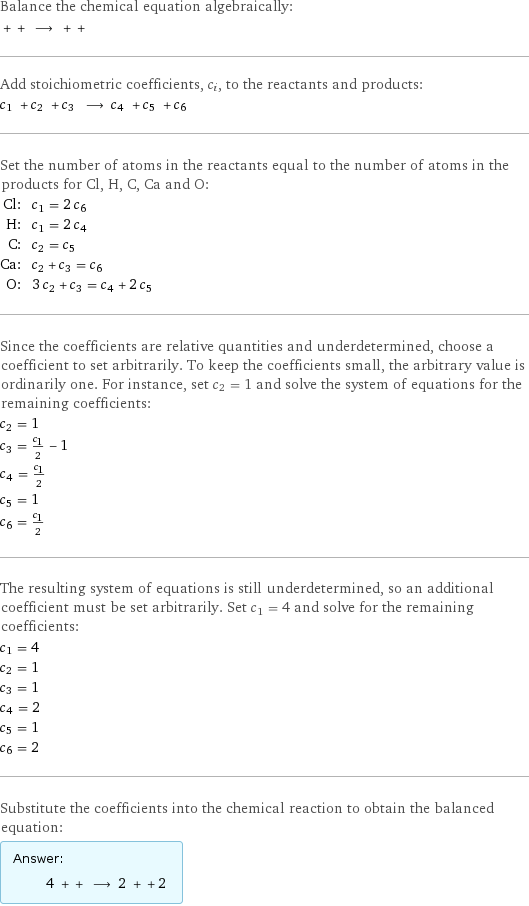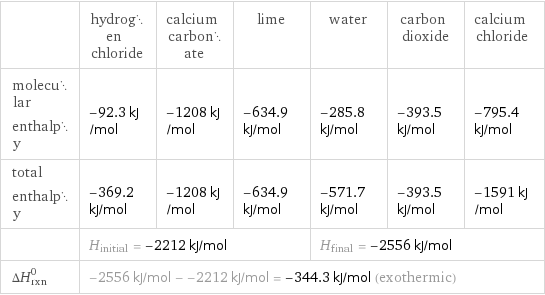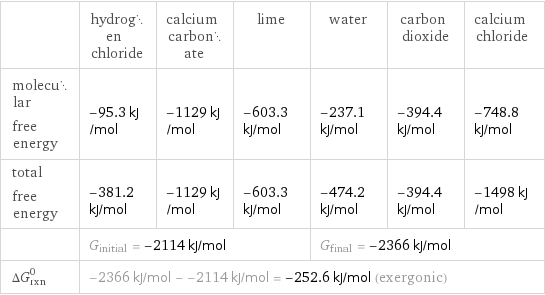Input interpretation

hydrogen chloride + calcium carbonate + lime ⟶ water + carbon dioxide + calcium chloride
Balanced equation

Balance the chemical equation algebraically: + + ⟶ + + Add stoichiometric coefficients, c_i, to the reactants and products: c_1 + c_2 + c_3 ⟶ c_4 + c_5 + c_6 Set the number of atoms in the reactants equal to the number of atoms in the products for Cl, H, C, Ca and O: Cl: | c_1 = 2 c_6 H: | c_1 = 2 c_4 C: | c_2 = c_5 Ca: | c_2 + c_3 = c_6 O: | 3 c_2 + c_3 = c_4 + 2 c_5 Since the coefficients are relative quantities and underdetermined, choose a coefficient to set arbitrarily. To keep the coefficients small, the arbitrary value is ordinarily one. For instance, set c_2 = 1 and solve the system of equations for the remaining coefficients: c_2 = 1 c_3 = c_1/2 - 1 c_4 = c_1/2 c_5 = 1 c_6 = c_1/2 The resulting system of equations is still underdetermined, so an additional coefficient must be set arbitrarily. Set c_1 = 4 and solve for the remaining coefficients: c_1 = 4 c_2 = 1 c_3 = 1 c_4 = 2 c_5 = 1 c_6 = 2 Substitute the coefficients into the chemical reaction to obtain the balanced equation: Answer: | | 4 + + ⟶ 2 + + 2
Structures

+ + ⟶ + +
Names

hydrogen chloride + calcium carbonate + lime ⟶ water + carbon dioxide + calcium chloride
Reaction thermodynamics
Enthalpy

| hydrogen chloride | calcium carbonate | lime | water | carbon dioxide | calcium chloride molecular enthalpy | -92.3 kJ/mol | -1208 kJ/mol | -634.9 kJ/mol | -285.8 kJ/mol | -393.5 kJ/mol | -795.4 kJ/mol total enthalpy | -369.2 kJ/mol | -1208 kJ/mol | -634.9 kJ/mol | -571.7 kJ/mol | -393.5 kJ/mol | -1591 kJ/mol | H_initial = -2212 kJ/mol | | | H_final = -2556 kJ/mol | | ΔH_rxn^0 | -2556 kJ/mol - -2212 kJ/mol = -344.3 kJ/mol (exothermic) | | | | |
Gibbs free energy

| hydrogen chloride | calcium carbonate | lime | water | carbon dioxide | calcium chloride molecular free energy | -95.3 kJ/mol | -1129 kJ/mol | -603.3 kJ/mol | -237.1 kJ/mol | -394.4 kJ/mol | -748.8 kJ/mol total free energy | -381.2 kJ/mol | -1129 kJ/mol | -603.3 kJ/mol | -474.2 kJ/mol | -394.4 kJ/mol | -1498 kJ/mol | G_initial = -2114 kJ/mol | | | G_final = -2366 kJ/mol | | ΔG_rxn^0 | -2366 kJ/mol - -2114 kJ/mol = -252.6 kJ/mol (exergonic) | | | | |
Chemical names and formulas

| hydrogen chloride | calcium carbonate | lime | water | carbon dioxide | calcium chloride Hill formula | ClH | CCaO_3 | CaO | H_2O | CO_2 | CaCl_2 name | hydrogen chloride | calcium carbonate | lime | water | carbon dioxide | calcium chloride IUPAC name | hydrogen chloride | calcium carbonate | | water | carbon dioxide | calcium dichloride